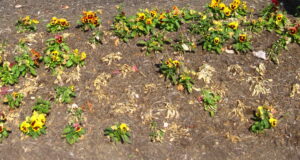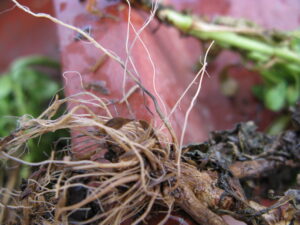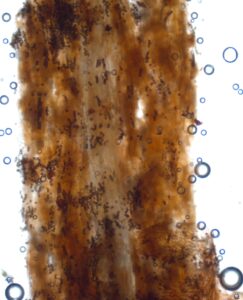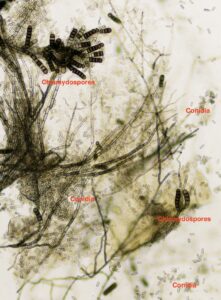
Figure 1. Pansies get a bad a rap for falling down in hot weather. Thielaviopsis is often the real culprit. Photo by Janna Beckerman.
Black root rot (BRR), caused by the fungus Thielaviopsis basicola,has a host range of several hundred plants. In the landscape, the most common hosts include pansies (Fig. 1), and vinca, along with calibrachoa and petunia. In perennial hosts, it often infects lavender, phlox, milkweed and butterfly-weed (Asclepius spp.). Even woody plants, like holly and elderflower (Sambucus spp.) can succumb.
Symptoms of black root rot are often mistaken for nutrient deficiencies. Older leaves may develop symptoms that look like iron chlorosis, while young leaves become stunted. Infected plants grow more slowly compared to healthy plants. Shoot length is reduced compared to healthy plants, and scattered dead shoots may be apparent. In pansy, one of the key symptoms of BRR is when seemingly ‘healthy’ plants may suddenly collapse when a brief hot spell occurs (Fig. 1).
Keep in mind that diagnosing any root rot requires observing the affected plant for symptoms, and collecting the infected tissue at the right time to culture out the pathogen or pathogens causing the problem. Fortunately, the black root rot pathogen creates both symptoms and even signs that can be observed with a little patience and a good hand lens. Carefully excavate roots, and wash them. Roots will be intact, but have blackened areas that are easily observed(Fig. 2). Honking chlamydospores may even be visible with just a hand lens or dissecting scope (Fig. 3), but the beauty and power of this pathogen requires a microscope (Fig. 4) to appreciate the sheer number of conidia (little square spores) and those honking chlamydospores.
- Figure 2. Clean roots showing the characteristic black root rot. Photo by Janna Beckerman.
- Figure 3. Looking at sectioned black root reveals numerous chlamydospores. Photo by Janna Beckerman.
- Figure 4. So many spores! A thin section at 400x magnification shows thousands of conidia (little rectangles) and a few dozen chlamydospores. Photo by Janna Beckerman
Managing BRR in the landscape can be a challenge, particularly in alkaline (high pH) soil. In beds with a history of this problem, the easiest thing to do is to rotate out from susceptible woody plants like holly or elderflower. Avoid annuals like pansy, calibrachoa, vinca and replace with more resistant annuals, like sweet alyssum, annual sage (Salvia), celosia, cosmos, dusty miller, portulaca and poppy. Resistant perennials include black-eyed Susan, coneflower, daylily, sea holly (Eryngium amethystinum), perennial Coreopsis, little bluestem (Schizachyrium scoparium), Russian sage, and yarrow.
Although there are fungicides labeled for production, their use in the landscape is to prevent infection from occurring, not ‘curing’ infected plants. In new plantings, any of the following products are labeled for treatment to protect new plants from becoming infected: Cleary’s 3336, Medallion, and Orkestra. As always, follow label directions for best results, and remember that repeated applications may be necessary for continued protection.


